How to choose a water filter
How often do we think about the question of what kind of water we use at home for drinking or for cooking? Alas, we have to admit that not everyone has yet come to fully understand the need for its purification and filtration. But this is by no means an idle question: the quality of water from autonomous sources or from the city network very often lies outside the limits of permissible sanitary standards. Simple boiling or settling can only help in part, and is unable to cope with the overwhelming number of contamination factors or even contamination.
It is gratifying that the number of supporters of a reasonable attitude to health, one's own and those of the immediate environment, is still growing. Direct evidence of this is the expanding popularity and demand for household appliances for water purification. Filter manufacturers are constantly working on improving their products, expanding the range of products. But the variety presented for sale can easily put a buyer in a "stupor" who buys such products for the first time, and who is not too knowledgeable about how to choose a water filter.
In this publication, there will be no detailed story about factors polluting water, about technologies for purifying it from certain substances, about the principles of operation of various filtering devices.
How are coarse and fine filters arranged and how do they work?
It is very important to know this, but it is not worth repeating. A separate large article of our portal is devoted to the question of the device and functioning of the various.
Therefore, today the focus will be mainly on consumer problems - what a person should choose in order to provide their homes with clean water. Let's take out “out of brackets” and complex powerful water treatment plants assembled from several column-type filters - only specialists should be engaged in their selection, assembly and installation. Let us consider the problem in the context of purchasing a ready-made filter or filtration complex in a specialized store, designed for the needs of one average family.
Performing any task should always start with a clear understanding of what you want to get in the end. When purchasing any, in fact, things or products, a person usually already has an idea of what functions or qualities he hopes to get for his money spent. The filter for water purification is no exception in this matter. It is required to confidently imagine what properties it should have.
A simplified approach like “just purify the water” is, of course, sheer amateurishness. Along with the obvious signs of pollution (which must also be dealt with skillfully), the water can contain substances or microorganisms that are completely invisible to the eye, smell or taste that pose a threat to human health.
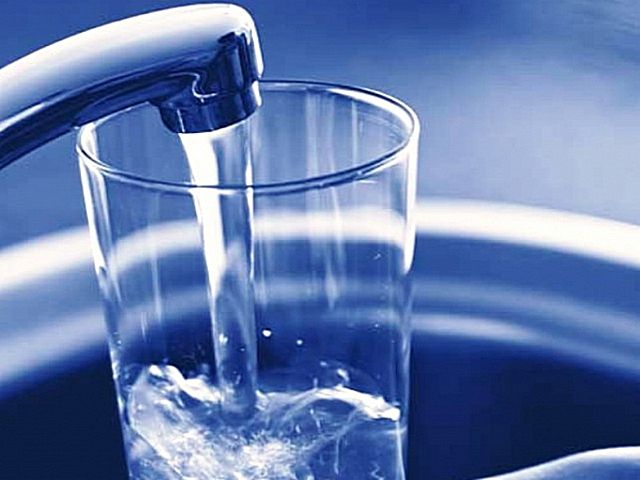
You should not trust either your superficial feelings or, even more so, the advice of your neighbors. Subjective opinions can lie in a wide range - from “we drink this water all our lives” to some far-fetched “horrors”, which are more likely to be classified as “urban legends”. And, besides, the quality of water from neighboring closely located sources, or even in neighboring houses of urban development, can vary significantly.
As a result, you can fall into one of two extremes:
- Buying a filter that doesn't have the required cleaning functions is a waste of money.
- Taking advantage of the apparent ignorance of the consumer, shop assistants will try to impose an expensive filtering system, which is absolutely unnecessary. In the end, this is also lost money.
The optimal solution is to take a sample of water from a source or water supply system for laboratory analysis. This, of course, also costs money, but such spending will be justified.

The most correct decision is to conduct a laboratory study of water from your source.
Analysis solves a lot of questions at once:
- You can immediately assess the fundamental suitability of an autonomous source for use in food needs.
- The analysis results will help you choose the right filter system. Re-analysis, after installing the filter, will give a clear picture of the effectiveness of its work.
- Regular testing will allow tracking the dynamics of changes in the biochemical composition of water - an extremely important event for autonomous, especially newly equipped sources.
- Having a laboratory test protocol on hand can become a document on the basis of which it will be possible to make claims against city utilities.
By the way, many thoughtful people, when purchasing new housing, immediately require a document on the quality of drinking water.
To conduct an analysis, you need to decide on a laboratory. You should not resort to the services of laboratories working at water supply organizations (there they can easily go for underestimating pollution indicators), and at companies involved in installing filtering and treatment systems (there, of course, there may be another extreme). It is best to choose an independent organization that has the appropriate government certification.
Laboratory analyzes are divided into two types - chemical and microbiological. For autonomous, especially surface sources, both are mandatory. For tap water, which, in theory, should have already passed the stage of disinfection, they are often limited only to a chemical test, although research on microbiology will also never be superfluous.
It is most reasonable to agree in advance with the laboratory workers about the time of delivery of the taken water samples, since there are certain restrictions on their shelf life (2 ÷ 3 hours).
Water intake also requires compliance with certain rules:
For chemical analysis it is necessary to hand over 1.5 liters.
- The optimal solution is a clean plastic bottle, but only from drinking non-carbonated water. It is forbidden to use containers from sweet drinks or beer.
- The tap opens, and the water is given at least 15 minutes for free exit. (If the source has not been used for a long time, then it will even take 2 hours).
- The bottle and cap are thoroughly rinsed with the same water that will be analyzed. No detergents are used.
- Then the pressure is set to a minimum, so that aeration is not created when entering the bottle - - the appearance of bubbles. Excess oxygen can greatly distort the overall picture.
- The container is filled completely, with an overflow, so that there is no air left under the tightly twisted cork.
For biological analysis, the requirements are completely different.
- The required volume is about 0.5 liters. The container must be absolutely sterile - if, for example, a glass jar is used, then both it and the lid to it are thoroughly steamed. Many laboratories practice taking samples for microbiology exclusively in their sterile disposable container, which is issued to the customer.
- To draw water, hands must be worn in sterile medical gloves.

For the "purity of the experiment" water sampling for biological analysis is carried out in sterile gloves
- Even before opening the tap, the cut of the spout is either burned by fire, or thoroughly treated with medical alcohol - it is required to completely exclude the ingress of microorganisms into the sample from the outside.
- The tap opens, and water is pumped under maximum pressure for at least 10 minutes.
- After that, the sterilized container (cold) is filled to the top, and immediately closed hermetically.
Typically, the lead time for a high-quality laboratory test of water is about 5-7 days. By the way, if they promise to do it literally in a day or two, this should alert. It happens that not entirely conscientious offices conduct a superficial rapid test, which is then issued as a deep study.
As a result, the customer must get his hands on a protocol certified by the established procedure, which has the force of a legal document.
As a rule, this is a table in which, for clarity, the maximum permissible norms for water, established by SanPiN, and the actually obtained indicators are indicated.
Having such a document in hand and highlighting the positions that require adjustment, it will be possible to select filters of the appropriate direction of action.

The laboratory test protocol will help determine the "strategy" of water purification, and can also help in filing claims against utilities
Is it possible to limit ourselves to conducting independent express tests, kits for which can be purchased in stores?
Experts have a unanimous opinion on this matter - such an analysis is not a full-fledged alternative to a laboratory one. Of course, he will show the presence of a problem, but he will not be able to determine the exact quantitative and component indicators of pollution, that is, there will be clearly not enough data for a qualitative selection of the filtering system.

And one more parameter that should be decided in advance is the required filter performance. If the article discusses devices for the purification of drinking water and for cooking, then we can proceed from the average rate of 3 liters per day per person. Of course, the filter should not work at the limit of its capabilities, that is, it is advisable to increase this rate, say, twice.
Thus, if, for example, five people live in a house (apartment), then it is easy to determine that approximately 30 liters of purified water per day will be required. Accordingly, the purchased device must cope with such a load.
Now let's move on to considering the various models of household water filters.
The simplest option: filter - jug
Filter jug device
For those who do not want to spend a significant amount on the purchase of a filter, do not need large volumes of purified water, or do not want to deal with any installation or connection of the system to the water supply system, it is advisable to get a "light version" - a jug. Of course, such a solution is only possible if the quality of the incoming water allows it.
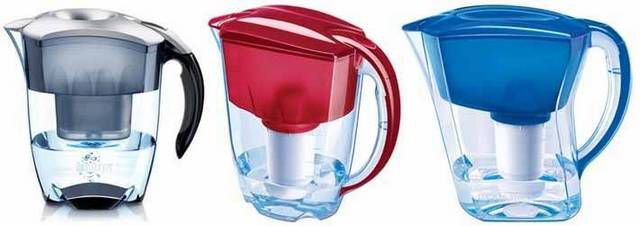
The simplest and most inexpensive, but far from the most effective solution is to purchase a jug filter.
Although externally, in shape and color, filter jugs can vary significantly. The basic design is always the same, and is not very complex.
In fact, these are two containers, separated by a partition and communicating only through a filter cartridge.
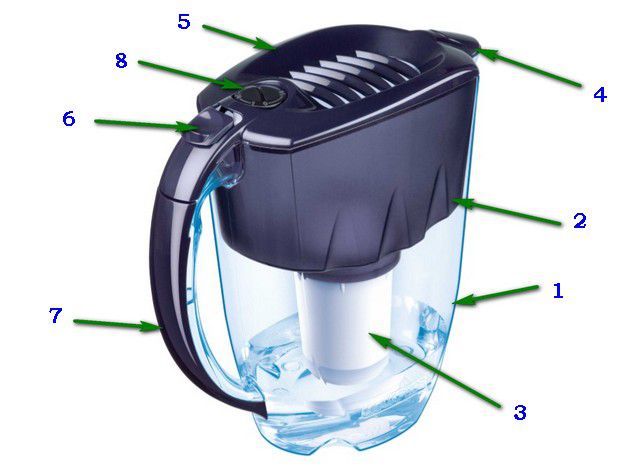
The jug body (pos. 1) is used to collect purified water. It is always made of transparent food-grade polymer, and a volume scale is often placed on its walls for ease of use. The capacity of the jug may vary - usually a number of models are on sale with a volume of filtered water in the range of 1.3 ÷ 4 liters. The choice for this parameter depends on the family's need for drinking water.
The upper container (pos. 2) is a liner in the body. It is also made of high-impact food grade plastic, but usually with a darker tone (the color may be different - depending on the design idea). This compartment is designed to receive water to be filtered, and its capacity is usually about half the useful volume of the jug.
In the lower part of the insert, where it forms a kind of funnel, there is a socket into which the filter cartridge is tightly inserted and fixed (pos. 3). The purpose, that is, the functionality of the cartridge can be different - it is selected on the basis of the existing "clinical picture" of the state of water.
It is important to know that the locking or threaded connection of the cartridge to the top container can vary significantly from manufacturer to manufacturer. Apparently, this is a method of incentivizing the purchase of only branded components.
There is a spout in the upper part of the body - for the convenience of directed drainage of filtered water (pos. 4). The design is such that even with a strong inclination of the jug, the water from the upper and lower compartments cannot accidentally mix.
Water collection for filtration is carried out with the lid folded back (pos. 5), which can be equipped with a convenient lock (pos. 6), or through the intake hatch, which also necessarily has its own lid to prevent accidental ingress of dust or debris inside.
The filter jug always has a convenient handle (pos. 7). On top of the lid or on the handle, a "reminder" can be placed - a mechanical calendar that will prompt the owner about the timing of the filter cartridge change. There are also expensive models with electronic indication. Moreover, when selling some brand models, registration of customers is practiced, who will subsequently receive Internet or SMS messages about the need to replace them.
The scheme of work is obvious - the water poured into the upper container independently, without any influence, only due to gravity, passes through the filling of the cartridge, receives the required cleaning and accumulates in the jug. As water is consumed for drinking or kitchen needs, new portions are poured into the receiving container.
Applicable cartridges
It is the cartridge that is the most important element of such a filter, therefore, special attention should be focused on its selection.
The shape of the cartridge and its locking part can be different, and there is almost no question of interchangeability, unless, of course, this is specified by the manufacturer.
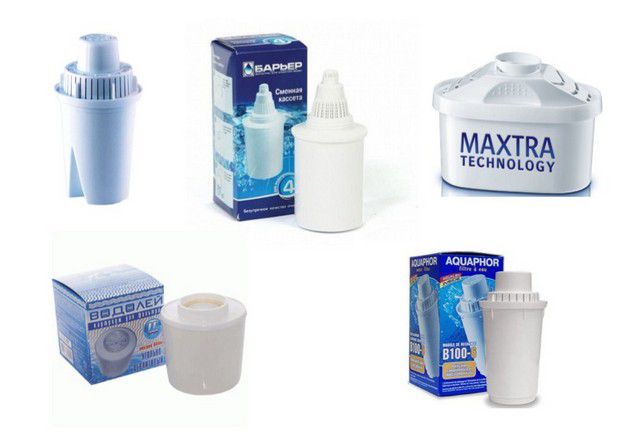
But cartridges for one filter model can have different purposes:
- Replacement elements for water of standard quality are on sale - they help to cope with possible unpleasant odors, normalize taste, remove heavy metal ions, chlorine impurities, organic compounds, etc. The usual sorption material for them is granular activated carbon.
- There are cartridges with a pronounced softening effect - a certain amount of ion-exchange resins is additionally introduced into them.
- You can also choose a cartridge for a source with a high iron content - they use reagent-free deferrization and filtration technology.
- For springs from which water does not pass the disinfection stage, there are special elements with a bactericidal effect.
- Cassettes are produced, the refueling of which assumes a healing fluorinating effect on water.
Most companies use some form of silver in cartridge fillers to prevent bacterial colonies from growing inside them. And besides, each of the manufacturers tries to surprise the consumer with their own original designs.
Usually there is a mesh or membrane at the inlet and outlet of their cartridge, which performs the function of mechanical filtration. In addition, usually in replaceable elements it has a special throttle device that equalizes the rate of passage of water through the filler, regardless of the filling level of the upper section of the jug.
Advantages and disadvantages. Options for selecting filter jugs.
The following can be said about the positive qualities of filter jugs:
- Their operation is the simplest one that any person can handle.
- There are simply no installation operations, except for connecting the cartridge. Ideal for work, dorm or rental housing.
- The jug can be easily taken with you as needed, for example, for a vacation trip.
- Low cost, affordable for any family.
There are also significant disadvantages of such filtering:
- Cleaning goes only in certain portions. For example, to draw a five-liter kettle, you will have to do two filter fillings.
- The cleaning speed is low, rarely reaches the threshold of 400 ml / minute, and more often even much less.
- Frequent (about once a month and a half) replacement of the cartridge is required. With a large consumption, the period may be even shorter.
- Quite high operating costs in terms of the volume of filtered water, when viewed from the perspective. So, after a year and a half to two years, the total costs may equal, or even exceed, the costs of a really powerful and high-quality multistage filtration unit.
Care should be taken when choosing a filter jug, as the market is replete with cheap fakes.
In no case do they buy them in random places - there are specialized stores for this. It is best to choose models from well-known brands.
Look carefully and literally sniff the body. The polymer should not emit any odors. Food grade plastic must be marked with the appropriate pictographic markings as shown in the figure.
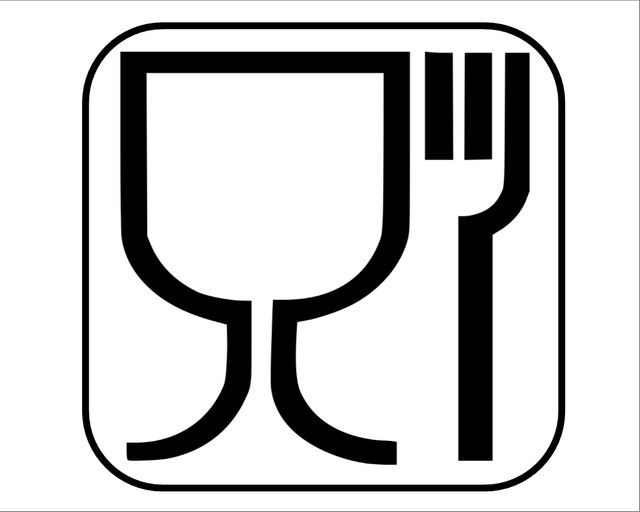
This sign says that "food grade" plastic was used to make the jug.
You should immediately evaluate the possibility of purchasing original replaceable cartridges of the required functionality, in accordance with the quality of the water source, and their affordability.
It is necessary to reasonably approach the choice of a jug in terms of volume. Remember - such a filter is not a "decanter" at all, but only serves to purify water. The capacity of the vessel should correspond to real needs with a small margin. It is not recommended to store filtered water for more than a day. This means that the surplus will simply have to be drained, wasting the resource of the replaceable cartridge in vain.
Usually for a single person or for a couple, a one and a half liter jug is enough. It is fashionable to think about buying a filter with a maximum capacity, about 4 liters, only if it will be used in a large family.
Purchased cartridges must be in their original sealed packaging. Their expiration date must be checked.
The convenience of the jug and its appearance are certainly important criteria, but they should still be judged last.
To complete the section on filter jugs - a small overview of popular models from well-known manufacturers and some cartridges for them.
| Model, short description | Illustration | Capacity (jug / funnel) or cartridge life (liters) | approximate cost |
|---|---|---|---|
| MANUFACTURER - "BARRIER" | |||
| Pitcher "Barrier-Style", compact layout, mechanical life indicator | 2.5 / 1.0 | 490 rbl. | |
| Jug "Barrier Grand NEO Rubin", volume scale, mechanical life indicator | 3.7/2.0 | RUB 550 | |
| Cartridge "Barrier - 7 iron" for standard and purification and deferrization of water | 350 | RUB 250 | |
| Cartridge "Barter-Ultra" for filtration and bactericidal treatment of water | 200 | RUB 400 | |
| MANUFACTURER - "AQUAPHOR" | |||
| Pitcher "Aquaphor Line" classic design, compact size | 3.2 / 1.4 | RUB 350 | |
| Pitcher "Aquaphor Prestige", mechanical indicator | 3.0 / 1.35 | RUB 540 | |
| Cartridge B100-15, universal action | 170 | 155 RUB | |
| Cartridge B100-6, softening | 300 | 320 RUB | |
| MANUFACTURER - "GEYSER" | |||
| Jug "Geyser Matisse-Chrome", graphite or deep blue color, high temperature resistant plastic | 4.0 / 1.5 | 840 rbl | |
| Jug "Geyser Dolphin" - stylish model, a choice of 5 shades | 3.0 / 1.4 | RUB 380 | |
| Geyser 502 cartridge, universal, with softening effect | 300 | RUB 210 | |
| Geyser 301 cartridge, universal type | 300 | RUB 170 | |
| MANUFACTURER - "BRITA" | |||
| Jug "Elemaris XL", with electronic cartridge resource indicator | 3.5 / 1.5 | 1450 RUB | |
| Jug "Marella XL", electronic indication | 2.2 / 1.2 | RUB 790 | |
| Brita Classic is a universal cartridge. Suitable for some models of Aquaphor jugs | 150 | 290 | |
| Brita Maxtra - cartridge with four stages of water purification | 150 | RUB 360 |
Video: review of filter jugs of the "Barrier" brand
Filters in the form of a nozzle on the faucet
Another type of filters that can be classified as the simplest water purification systems.

As the name implies, these devices are simply slipped onto the faucet spout. Filtration of water is a flow-through method, due to the pressure in the pipes. This makes it possible to use carefully compacted sorbent filling in such filters, in contrast to jug cartridges, that is, to improve the quality of water purification.
The design of the nozzle filters can be different. The simplest ones are a cylinder with a filter pad, which is put on directly on the spout. The device of one of the models is shown in the diagram:
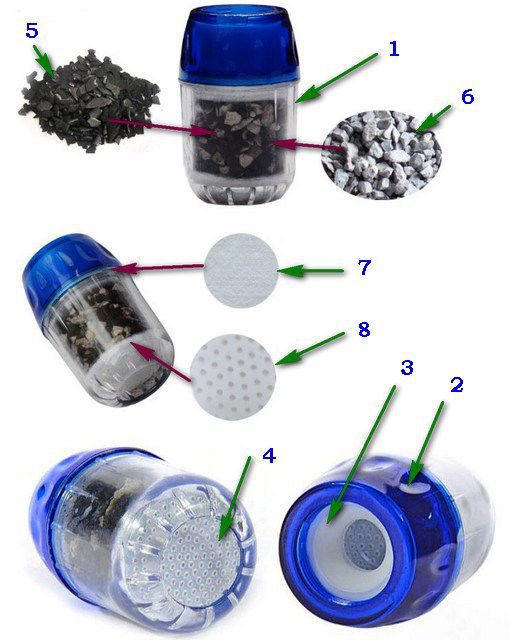
This is a cylindrical body made of transparent or opaque food grade plastic (pos. 1). The design can be non-separable, disposable, or it can be equipped with a removable cover (item 2), which allows replacing the filter bed or installing a cartridge.
A device for tightly fitting the filter onto the mixer spout is required. In this case, it is a rubber collar (item 3), but there can also be a threaded connection or adapters for the landing seat, in which a divider-aerator is usually installed on the mixer. At the bottom of the filter, at the water outlet, there can be its own divider (pos. 4), according to the principle of a shower.
A sorbent backfill is located inside the cylinder or cartridge. The example shows a mixture of activated carbon (item 5) and mineral chips (item 6) required for reagent-free water purification from iron and other dissolved impurities.
The backfill is protected from above and below by filtering membranes. The upper (pos. 7) cleans the water from insoluble suspensions, the lower (pos. 8), in addition, prevents small particles of sorbent and iron oxidation products from entering the purified water.
As already mentioned, the design can also be non-separable, that is, the filter itself is a cartridge that is disposed of as the resource is depleted.
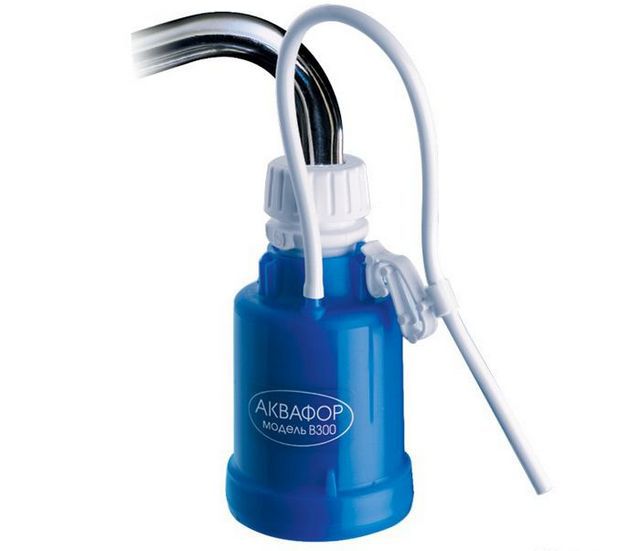
Such a scheme is very inconvenient in operation - you have to often put on and remove the filter from the tap
The disadvantage of such a scheme is the need to attach a filter to the mixer spout when there is a need for filtered water. This issue has been resolved in models equipped with a stream switching device - a divertor.
In this case, the main filter cylinder with the installed cartridge is installed offset to the side. Switching the diverter faucet allows you to either open a direct flow of unfiltered water, or redirect it for cleaning - its own, separate opening is provided for the outlet.
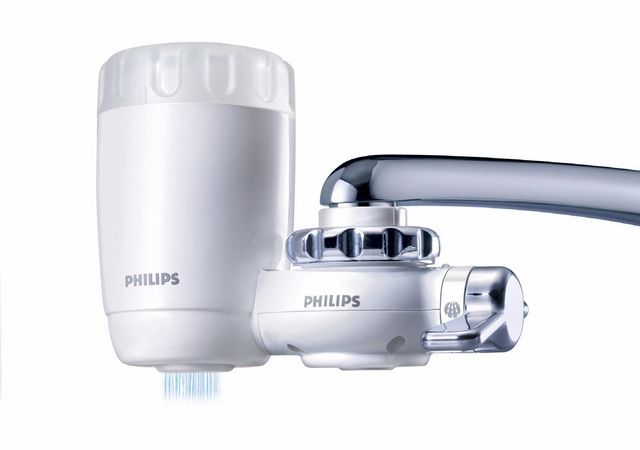
More convenient scheme - filter nozzle with mode switch - divertor
The main advantage of these filter attachments is their small size. Commercially available adapters allow such devices to be installed on almost any mixer, both with smooth twists and with a threaded coupling.
The service life of the cartridges is usually significantly higher than that of filter jugs, due to the density of the sorption filling.
However, the productivity of such filters or cartridges for them is low, usually not exceeding 200 ÷ 300 ml / min. That is, in order to simply fill the kettle, you will have to stand a lot near the sink. Many non-separable models do not differ in a variety of functionalities for water purification - filtration in them is reduced to an average minimum.
They are not very convenient during operation. If the filter is removable, then any worries of filtered water requires the installation of the device and its subsequent removal. In the case when the filter is made according to the scheme with a divertor and is constantly located on the outlet of the mixer, it clutters up the working space in the sink, which can cause certain inconveniences, for example, when washing large dishes.
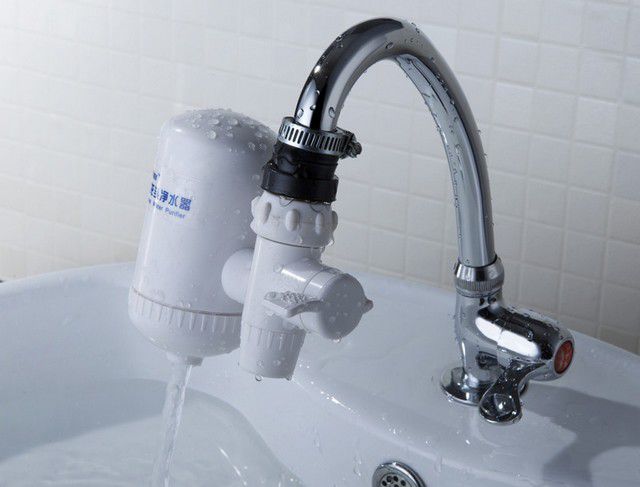
It is quite difficult to adapt to the right choice of pressure for high-quality filtration - if the water speed is too high, the quality of its purification decreases sharply. In addition, there is a very high probability of accidental start-up of hot water through the filter element, which leads to the rapid exhaustion of the cartridge of its resource, the need for replacement or certain regeneration operations.
| Model | Short description | Illustration | average price |
|---|---|---|---|
| "Aquaphor B300" | One of the simplest filters in the device is the attachments. Water purification from chlorine, mechanical impurities. Adapter included. Resource - up to 1000 liters. Filtration rate - 300 ml / min. | from 130 rubles. | |
| "Aquaphor Topaz" | Model with diverter switch. Purification - sorption one-stage. Replaceable filter module (cartridge) with a resource of 750 liters. Filtration rate - 300 ml / min. Dimensions 132 × 95 × 58 mm. Mechanical calendar memo. | 390 rbl. | |
| "Barrier Select" | Filter attachment with divertor, in stainless steel housing. Filter element with normal sorption and with ion-exchange resin for water softening and deferrization. The resource of the cartridge is 500 l or 3 months of operation. Set of adapters for connection to any mixer | RUB 620 | |
| DeFort DWF-500 | Filter attachment with divertor. Increased resource of the replaceable module and filtration rate - 5000 liters and up to 20 l / min. respectively. Dimensions 158 × 136 × 80 mm, weight in a state not filled with water - 430 g. | RUB 540 |
Tabletop filter attachments
The connection diagram of such filters, in principle, differs little from the nozzles on the mixer discussed above. The main difference is that the body itself with the filter module is located on the kitchen countertop in the immediate vicinity of the sink, and a flexible tube connects it to the mixer outlet.

By increasing the volume of the filter module, the productivity of the device, the quality of water purification and the resource of the sorption material are significantly increased.
Typically, these filters are made in the form of a vertical cylinder. The schematic diagram of any of them in general terms corresponds to the above diagram:

The cylindrical body (item 1) contains a replaceable filter module (item 2). Its significant volume makes it possible, if necessary, to use several types of sorbent filling for thorough multilateral water purification (pos. 3). There are models without replaceable modules - as the resource is consumed, the filling is replaced or regenerated in them.
The filter is equipped with its own spout (pos. 4) for easy collection of purified water into the dishes. Quite often a powerful ring magnet (item 5) is installed at the outlet of the module for additional "healing" of water. The body is closed from above with a cover (pos. 6).
At the bottom of the replaceable cartridge or working cylinder, there is a coupling (pos. 7) for connecting a flexible tube (pos. 8) that goes to the mixer outlet. The connection itself to the mixer can be carried out using an adapter sleeve (pos. 9) or through a diverter (pos. 10).
Diverters, as a rule, are purchased separately - they are always presented in stores that sell filters - there is an opportunity to choose for a specific type of mixer.
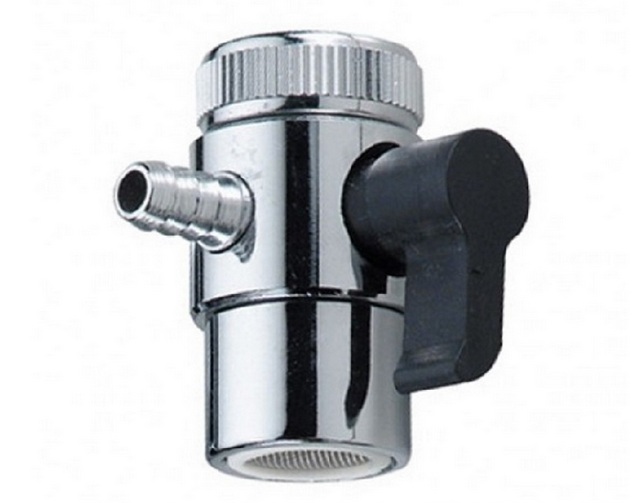
The advantages of such tabletop filter packings are increased resource and productivity. The device does not obstruct the space directly above the sink.
However, there are also many disadvantages. The structure is quite voluminous and will take up a lot of usable space near the sink, to which it is "tied". When using a sleeve connection, the inconvenience is the same as with a compact nozzle - the need to connect and disconnect with each set of filtered water. If a connection with a divertor is used, then a tube extending from it may be an obstacle.
The collection of water from such a filter requires care - careless switching on will lead to spilling of liquid on the table surface. The likelihood of accidental start-up of hot water into the filter is fully preserved.
| Model | Short description | Illustration | average price |
|---|---|---|---|
| "Aquaphor Modern" | Spindle-shaped body, side-mounted spout. Dimensions 273 × 117 mm. Filtration rate - up to 1.2 l / min. The resource of the replaceable cartridge B200 is up to 4000 liters. Mechanical calendar - memo. | 770 RUB | |
| "Barrier Optima" | Original design, microprocessor control over the residual resource of the filter module. Swivel spout. The resource of the cartridge is up to 1500 liters. Filtration rate - up to 1 l / min. | 1200 RUB | |
| Rodnik-3M | Wall-mounted model. Dimensions 315 × 120 mm. Weight empty with water - 1 kg. The resource of the replaceable module is 3600 liters. Filtration rate - up to 2 l / min. | RUB 790 | |
| "Geyser 1 UZH EURO" | A modern model with a wide selection of filter modules of various functionality with the possibility of regeneration. Module resource - up to 25,000 liters, including without regeneration - up to 7,000 liters. Filtration rate - up to 1.5 l / min. | RUB 1,500 |
Under-sink filter systems
More and more popular among users are gaining universal installations for filtration and fine post-treatment of water, which are usually located under the kitchen sink.
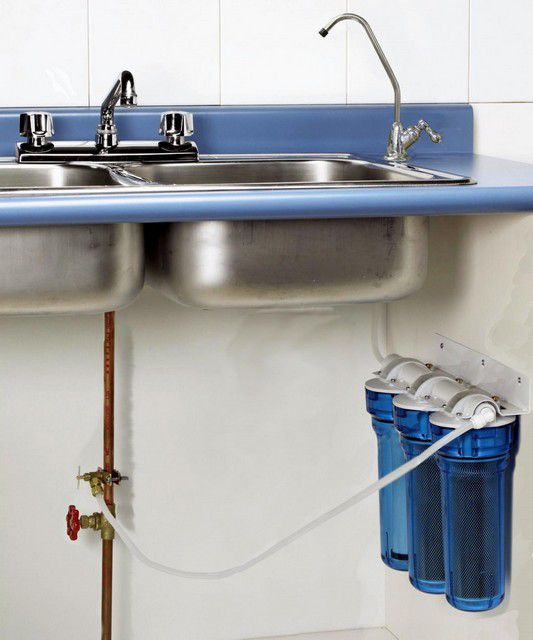
The most rational solution is to hide the filter system under the kitchen sink.
Structurally, such systems are usually a series of cartridge-type filters, each with its own cartridge of a certain type of action. (The construction of such filters is described in detail in the article, the link to which is posted above). Water along the path of movement from the water supply system to the point of analysis sequentially passes through all the modules, which provides a comprehensive treatment of the highest class.
All filters, as a rule, are assembled on one console with a system of channels or pipes for transferring water from one module to another. There are models with a case design, in which the entire system is closed with a casing.

The arrangement of the filter flasks is most often linear. In some multistage systems, it is possible to arrange in two rows or in two tiers, with vertical and horizontal placement of modules.
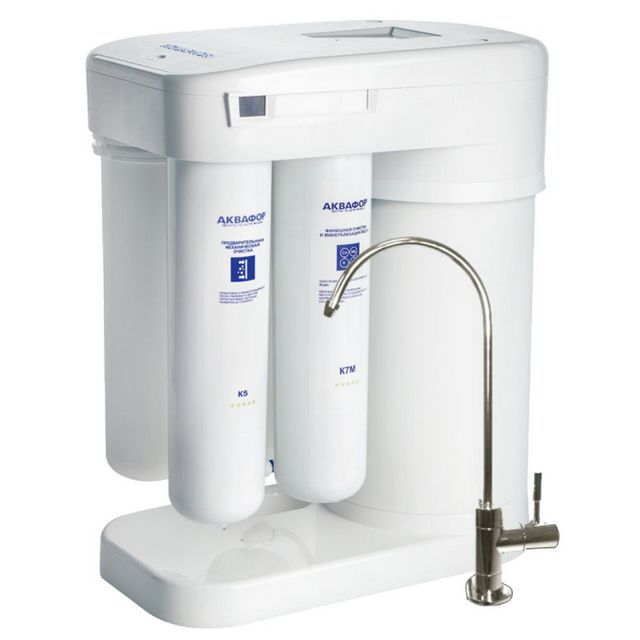
The number of modules, that is, and cleaning stages: from the minimum - one, to four, and sometimes even five. This leads to the highest "flexibility" of the system - the mounting dimensions of replaceable cartridges, as a rule, are uniform for one manufacturer, which makes it possible to accurately select the general characteristics of the entire complex, depending on the results of a laboratory study of water.
Such complexes are very easy to use. When they are installed, the water supply is immediately connected to the water supply, and a separate tap is installed on the sink, connected to the last stage of filtration. At any time, you can substitute the container, open the tap and collect the required amount of purified water. Moreover, the diameter of the switching pipes, connecting channels and the parameters of the external tap provide the optimal pressure for high-quality filtration - there is no risk of exceeding it. In addition, the likelihood of accidentally letting hot water into the filter modules is completely excluded.
The disadvantages of such complexes can be considered only a certain complexity of the initial installation, although for the owner who is familiar with basic plumbing techniques, there should not be any special problems. And the relatively high cost of such complexes can hardly be attributed to disadvantages - the high quality of cleaning is worth such costs, and the considerable resource of replaceable modules ensures a quick payback of the filtering installation.
The choice of such filtering systems has its own characteristics.
- Since the installation is supposed to be hidden under the sink, the issues of external design, as a rule, are not among the primary ones. It is much more important that the dimensions of the complex correspond to the real dimensions of the space allotted for its installation.
- Since the system involves, most often, multi-stage cleaning, you should focus not on the persuasion of the sales assistant, but on the available laboratory test results. It is important to prioritize in advance in order to choose the right modular content for the kit.
- Some complexes have expanded functionality - after the first stage of mechanical cleaning, there is a branch to a conventional mixer or to a dishwasher, heater, etc.
- When evaluating the performance of the complex as a whole, one should be guided by the indications of the "slowest" cartridge. Usually, at the outlet from the faucet, a flow rate of about 1.5 ÷ 2 liters per minute is provided - a completely acceptable characteristic.
- Filter modules may differ in the size of their resource. The owner will have to monitor this on his own, since, perhaps, the change of cartridges will sometimes need to be performed not all at once, but “stepwise”. Some modules lend themselves to periodic regeneration.
Of course, you should check the delivery for completeness. Usually, the system is supplied with everything necessary for its complete installation - a suspended or floor console, flasks, a set of cartridges (you can often choose it at your discretion), a tee for tapping into the water supply with a pressure regulator, connecting pipes, a tap for installation on a sink, a key for "Packing" of flasks with cartridges. Sometimes the kit also includes additional accessories - all this is indicated in the product passport.
| Model | Short description | Illustration | average price |
|---|---|---|---|
| "Aquaphor Solo Crystal" | The simplest system of one-stage sorption purification. Dimensions 260 × 340 × 90 mm. Productivity up to 2.5 l / min. | RUB 2500 | |
| "Aquaphor B510-08" | Replaceable module for deep water purification. Resource - 4000 l or 6 months. exploitation | 350 - 400 rubles. | |
| Atoll A-211Eg (D-21s STD) | Two-stage system with mechanical and sorption filtration and hard water softening. Dimensions 355 × 365 × 145. Productivity - up to 3.8 l / min. | RUB 7300 | |
| Atoll A-211E + Atoll A-211E g | Additional set of cartridges designed for 2 years of operation with a change every 6 months | 4000 rbl | |
| "Barrier Expert Complex" | Three-stage purification system - mechanical filtration, sorption purification, water softening and deferrization. Dimensions 368 × 267 × 95 mm. Productivity - up to 2 l / min. | RUB 3700 | |
| "Expert Complex" | A set of cartridges. Resource 10000 liters or 1 year of operation | 1400 RUB | |
| "Aquaphor Crystal ECO N" | System with four stages of cleaning, including disinfection, softening, iron removal, mineralization and water conditioning. Dimensions 377 × 342 × 92 mm. Productivity - up to 2.5 l / min. | RUB 4800 | |
| "Aquaphor" K3, KN, K7 and K7V | A set of four replaceable cartridges with increased resource - 8000 liters or 18 months. exploitation | 2200 rbl |
Video: the advantages of the Aquaphor-Trio water filter
Flow-through main filters of the "Fibos" type
Another type of filter in which water is purified by passing through the filter element under the action of pressure in the water supply system or the pressure created by a pump if the water source is autonomous. These filters are built directly into the line, that is, into the pipe through which water is supplied to the tap. This is convenient, since the initial connection of the filter is a one-time procedure and, as a rule, is performed by a specialist plumber. But anyone with basic plumbing skills can easily handle it.
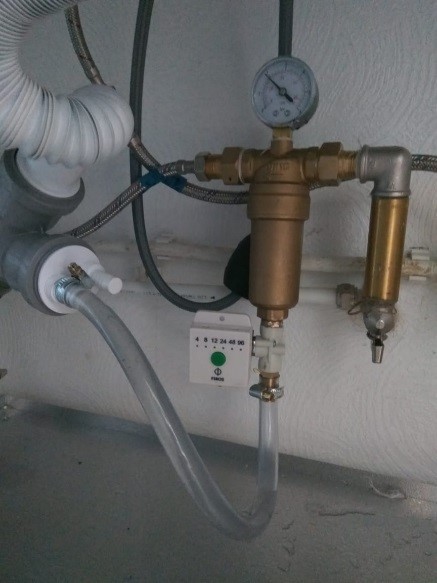
The advantage of main-line filters is that pure water flows from the tap, which can be used for any purpose. In addition, you can install one filter for several points of water sampling (kitchen, bathroom, bathroom, washing machine, dishwasher, etc.).
Let's analyze the operation of these filters using the Fibos filters as an example.

- Untreated water flows into the outer flask of the filter.
- It passes under pressure through a filter element - a cloth wound with an ultra-thin microwire. The distance between the microwire turns is 1 micron.
- Contamination remains on the outside of the flask.
- Pure water from the filter element is supplied to the tap and to household appliances.
- Contamination is removed from the outside of the flask simply by opening the drain valve.
Microwire is the main thing in the filter. What is it and how does it filter?
Currently, the world's only mass production of microwire is located in Russia. Its production technology was effectively developed back in the USSR. The main areas of use of microwire are military and space industries.
Microwire is an ultra-thin metal filament covered with glass insulation. Its thickness is no more than 25 microns, which is 40 times less than a millimeter.

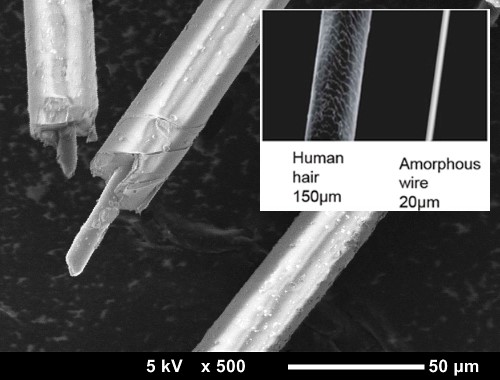
In the filter element, the microwire is wound with a distance between the turns of 1 micron. Only water passes through it, and impurities remain in the outer flask of the filter, then they are removed by opening the drain valve at the bottom of the Fibos filter. The glass coating of the microwire is necessary to prevent impurities from adhering to the filter element and to be easily washed off during washing.
If you look at the photo of the Fibos filter element under a microscope, you can see a metal core and a glass sheath covering it. Looking closely, you can see the gap between the turns, which is about 1 micron.
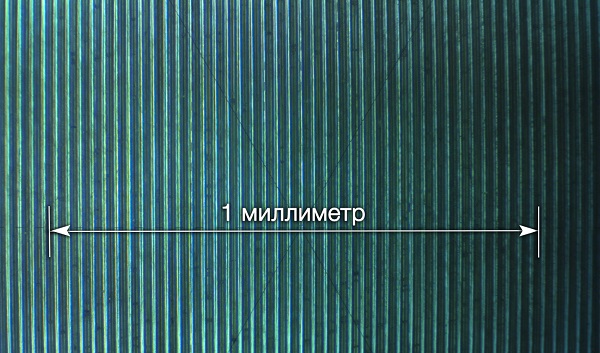
In addition to fine water purification from mechanical impurities, Fibos filters provide protection against bacteria. Bacteria attach to mechanical particles, forming a thin biofilm on them. Thanks to its ultrafine filtration, the Fibos filter completely stops them.
If necessary, to soften water, remove chlorine, reduce iron content in water, after the main filter of the Fibos type, an inexpensive cartridge filter with appropriate properties can be supplied. Cartridges last much longer, change less often, since preliminary fine cleaning is done by the Fibos filter.
In terms of performance, there is a line of Fibos filters from 5 l / min for the kitchen, 16.5 l / min for an apartment or summer cottage, 50 l / min for a cottage, 83 l / min for a cottage, a pool up to industrial designs at 1000 l / min ...
Fibos filters operate at water pressures from 0.5 to 16 bar. Includes a pressure gauge that shows the pressure in the system.
Another plus for these filters: they practically do not reduce the pressure in your water supply system.
For ease of use, devices for their automatic washing are connected to the Fibos filters.
The filters are compact, with a height of 146 mm to 183 mm without a pressure gauge and a flush cock.
| Model | Description | average price |
|---|---|---|
| Convenient small filter under the sink. Produces 5 liters of water per minute. Filtration fineness 1.0 microns. 3/4 "or 1/2" line connection (with adapter). Water temperature up to + 95 ° C. | RUB 6,990 | |
| Compact filter for a summer house or apartment. Produces 16.5 liters of water per minute. Filtration fineness 1.0 microns. 3/4 "or 1/2" line connection (with adapter). Water temperature up to + 95 ° C. | RUB 8,990 | |
| An excellent filter for a country house or cottage. Produces 50 liters of water per minute. Filtration fineness 1.0 microns. Line connection 1 "or 3/4" (with adapter). Water temperature up to + 95 ° C. | RUB 13,990 | |
| The filter is ideal for cottages, swimming pools. Produces 83 liters of water per minute. Filtration fineness 1.0 microns. Connection to the line 1.25 "or 1" (with adapter). Water temperature up to + 95 ° C. | RUB 23,990 |
Reverse osmosis filters
The highest rates of water purification from any impurities, chemical or bacteriological contaminants are shown by filtering installations, in which, in addition to conventional purification, a stage operating on the principle of reverse osmosis is used.
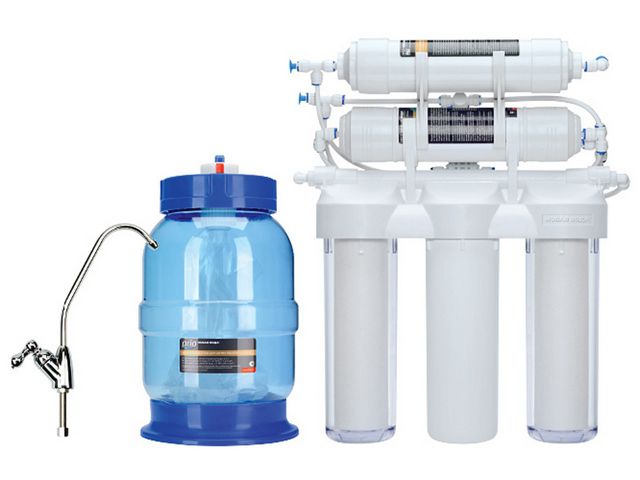
For "apologists" of crystal clear water - installations with a purification system based on the principle of reverse osmosis
First, what is reverse osmosis?
If the vessel is separated by a membrane with microscopic pores, and then liquid with different concentrations of impurities is poured into these sections, the system will not work in equilibrium. The liquid from the compartment with a lower concentration will spontaneously tend to the opposite one, in order to thus equalize the total concentration. This phenomenon is called direct osmosis.
But if an external influence is applied to the volume of a more concentrated liquid - to increase its pressure, then the overflow through the membrane will begin in the opposite direction. And only the size of the cells of the membrane will determine what will go to the next section.
This is exactly how reverse osmosis filtering units work.

Schematically - what is the reverse osmosis process
Water enters the filter module under pressure (arrow no. 1). The module itself is divided into two parts by a membrane (red arrow), the size of the micro-holes of which is only about 0.3 nm, so that they allow water molecules to pass through. Thus, small-sized water molecules penetrate into the second half, from where the filtered water flows to the points of accumulation or consumption (arrow 3). All larger molecules, not to mention mechanical suspensions, bacteria and even most viruses are reliably retained on the membrane, and are removed together with the concentrated solution into the drain (arrow 2). It is common to see the proportion of ⅓ of the total volume of treated water and ⅔ of the discharged concentrate.
In principle, such a scheme is capable of independently purifying water of any degree of pollution. However, in order not to "overload" the membrane, and so that its pores are not overgrown, several stages of pre-filtration are provided. In addition, some molecules (for example, free chlorine, which is constantly present in tap water) are smaller in size than water molecules, and they must be disposed of in advance. Therefore, pre-filtration includes not only mechanical, but also sorption purification.
At the outlet, water is obtained, which in its characteristics approaches distilled water. From the point of view of purity, this is excellent, but from the point of view of consumer qualities, it is not very good. Such demineralized water is devoid of even the slightest taste and smell, it is of little use for drinking, and the dishes prepared from it will not be the most delicious. Moreover, many doctors agree that water of a similar degree of purification can even be harmful to the human body.
To eliminate this disadvantage, additional modules are usually installed after reverse osmosis in household filter systems. Usually it is a mineralizer that enriches the water with mineral salts necessary for humans. A carbon post-filter, a biothermal module, which normalizes the bio-composition of the water, can also be installed. And if special sterilization is required, then an ultraviolet lamp can also stand at the end of the cycle.
The cost of such installations is quite high, so it is necessary to immediately determine how much there is a need for it. In addition, a number of important criteria are taken into account when choosing.
- The reverse osmosis process requires a minimum pressure of about 2.8 bar. Plumbing systems do not always meet these indicators. This means that either the installation of a pump that increases the pressure in the system will be required, or it will be necessary to purchase a complex equipped with a built-in pump. That is, there will be a need to organize more power supply.
- Very "how many" is the issue of the performance of the filtration plant. Here it is important to find a "golden mean" so that both the need for clean water is provided and unnecessary surpluses are not created. It should not be forgotten that in order to get a liter of purified water, about two liters will have to be drained into the sewer. That is, it would be extremely unreasonable to use such water for economic purposes.
Even the smallest units are capable of delivering up to 100 liters per day - this is more than enough for any family. So chasing high rates is hardly worth it, especially since this is reflected in the cost of the installation itself.
- It is necessary to decide which installation will be more convenient to use - storage or flow-through. In flow-through systems, filtration occurs only with an open water tap - more efficient membranes are installed. In another version, the system has its own storage tank - the filtration process is carried out only when necessary - when the total volume of accumulated purified water is reduced to a certain level. It is very convenient - the owners always have a supply of clean water. The disadvantage is the considerable dimensions of the assembly. But on the other hand, the price of such complexes is much lower.
The most expensive module, of course, is the reverse osmosis, but its resource is quite large - the membrane usually can withstand up to three years of operation. The rest of the replaceable cartridges are changed more often, as the resources laid down in them are depleted. Typically, pre-filters last up to six months, and the post-purification carbon cartridge - up to a year. After its depletion, water can "signal" a bitter taste.
The cost of such installations really looks daunting. However, if you sit down with a pencil and a calculator in your hands and bring the entire volume of costs over several years to the cost of one liter of filtered water, you can make sure that it will still be cheaper by almost an order of magnitude than buying bottled purified water, which, by the way, is They are also produced using reverse osmosis technology.
| Model | Short description | Illustration | average price |
|---|---|---|---|
| "Aquaphor OSMO 100 PN isp.6" | Three-stage pre-cleaning, mineralizer and post-filter. Storage tank 10 l. Built-in pump. Productivity is 15.6 l / h. | RUB 14,000 | |
| Geyser Prestige PM | Six stages of preliminary and post. cleaning. Storage tank 12 liters. Productivity - 12 l / h. Two tap positions - for pure and saline water. | RUB 14,100 | |
| "Barrier Profi Osmo 100 boost" | Five-step cleaning, built-in pump. Storage tank for 8 liters. High productivity - up to 20 l / h. | RUB 11,000 | |
| "Atoll A-560E SailBoat" | The original monoblock design makes it easy to install the system in the space under the sink. Dimensions 410 × 420 × 240 mm. 5 stages of cleaning. Built-in 8 l membrane tank. Productivity - up to 6 l / h. | RUB 20,000 |



